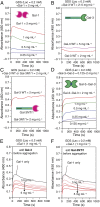Design-functionality relationships for adhesion/growth-regulatory galectins
- PMID: 30718416
- PMCID: PMC6386680
- DOI: 10.1073/pnas.1813515116
Design-functionality relationships for adhesion/growth-regulatory galectins
Abstract
Glycan-lectin recognition is assumed to elicit its broad range of (patho)physiological functions via a combination of specific contact formation with generation of complexes of distinct signal-triggering topology on biomembranes. Faced with the challenge to understand why evolution has led to three particular modes of modular architecture for adhesion/growth-regulatory galectins in vertebrates, here we introduce protein engineering to enable design switches. The impact of changes is measured in assays on cell growth and on bridging fully synthetic nanovesicles (glycodendrimersomes) with a chemically programmable surface. Using the example of homodimeric galectin-1 and monomeric galectin-3, the mutual design conversion caused qualitative differences, i.e., from bridging effector to antagonist/from antagonist to growth inhibitor and vice versa. In addition to attaining proof-of-principle evidence for the hypothesis that chimera-type galectin-3 design makes functional antagonism possible, we underscore the value of versatile surface programming with a derivative of the pan-galectin ligand lactose. Aggregation assays with N,N'-diacetyllactosamine establishing a parasite-like surface signature revealed marked selectivity among the family of galectins and bridging potency of homodimers. These findings provide fundamental insights into design-functionality relationships of galectins. Moreover, our strategy generates the tools to identify biofunctional lattice formation on biomembranes and galectin-reagents with therapeutic potential.
Keywords: glycoconjugate; lectin; parasite; tumor.
Copyright © 2019 the Author(s). Published by PNAS.
Conflict of interest statement
The authors declare no conflict of interest.
Figures





References
Publication types
MeSH terms
Substances
Grants and funding
LinkOut - more resources
Full Text Sources
Molecular Biology Databases
Research Materials

